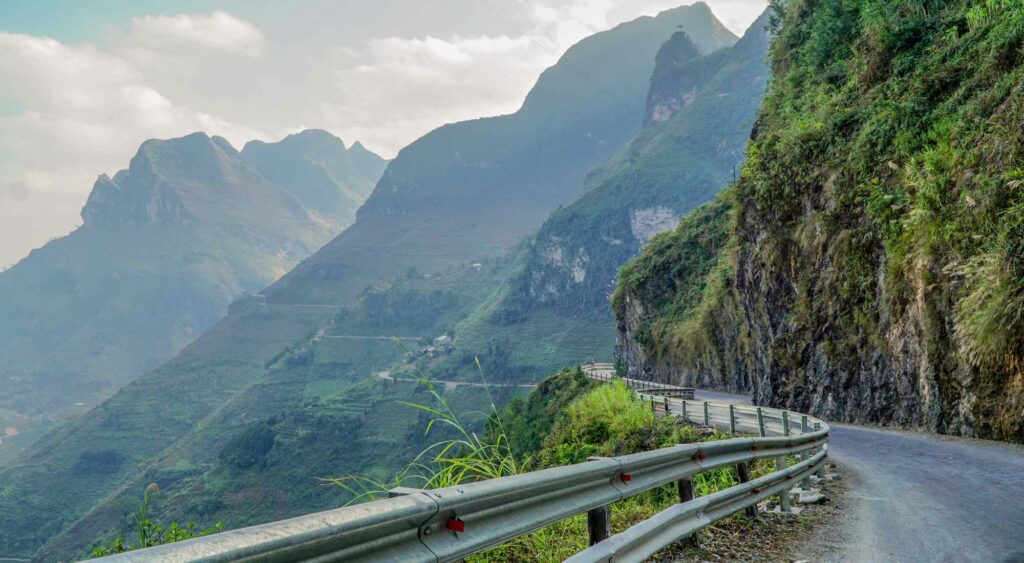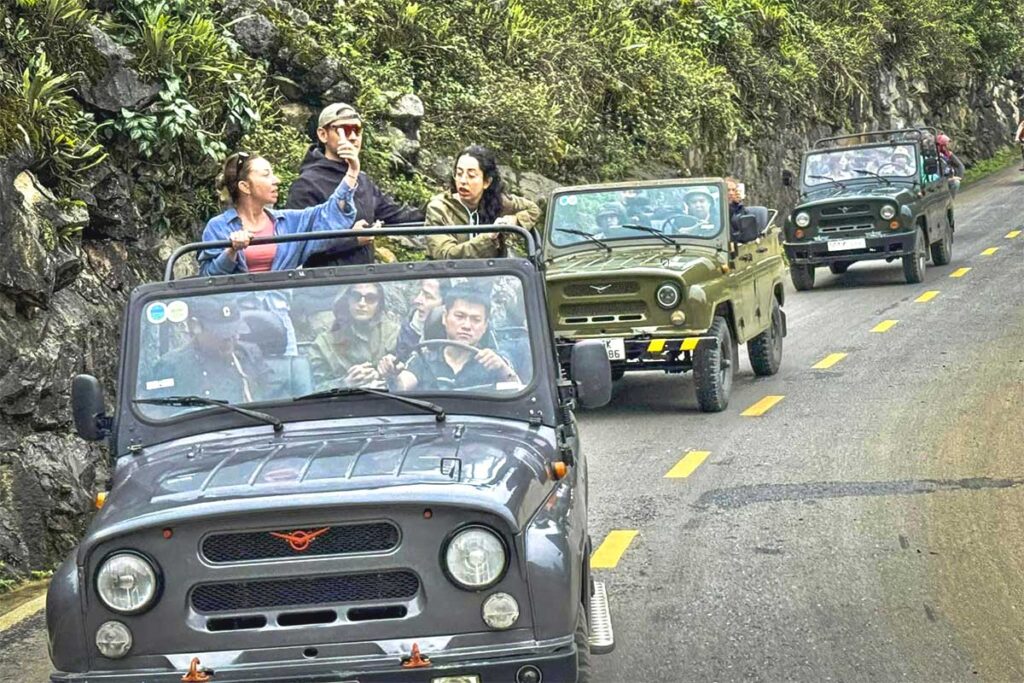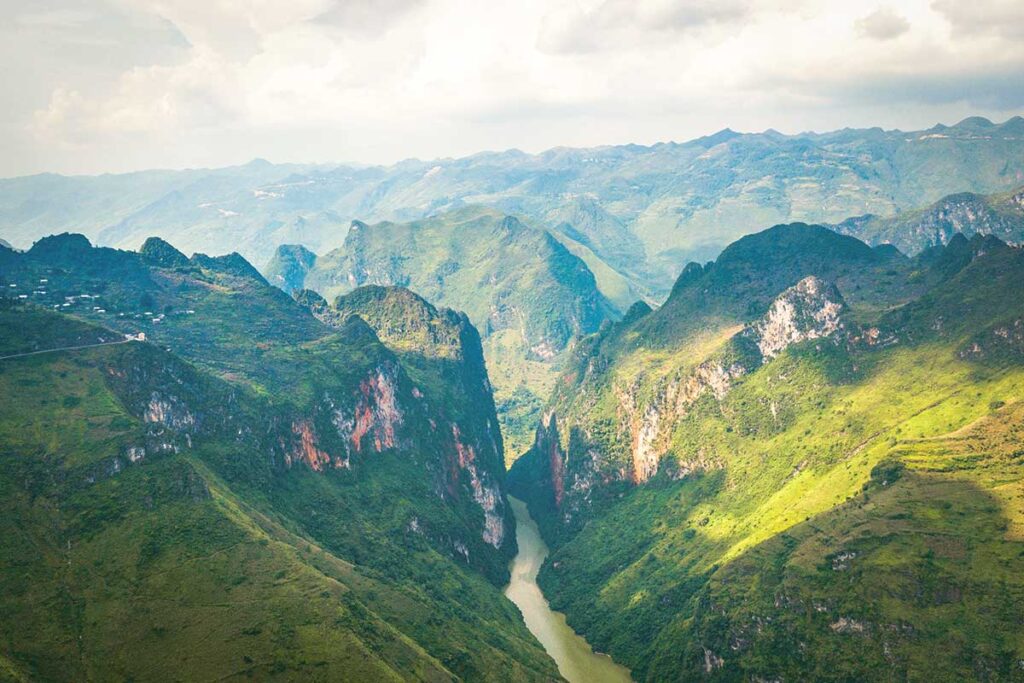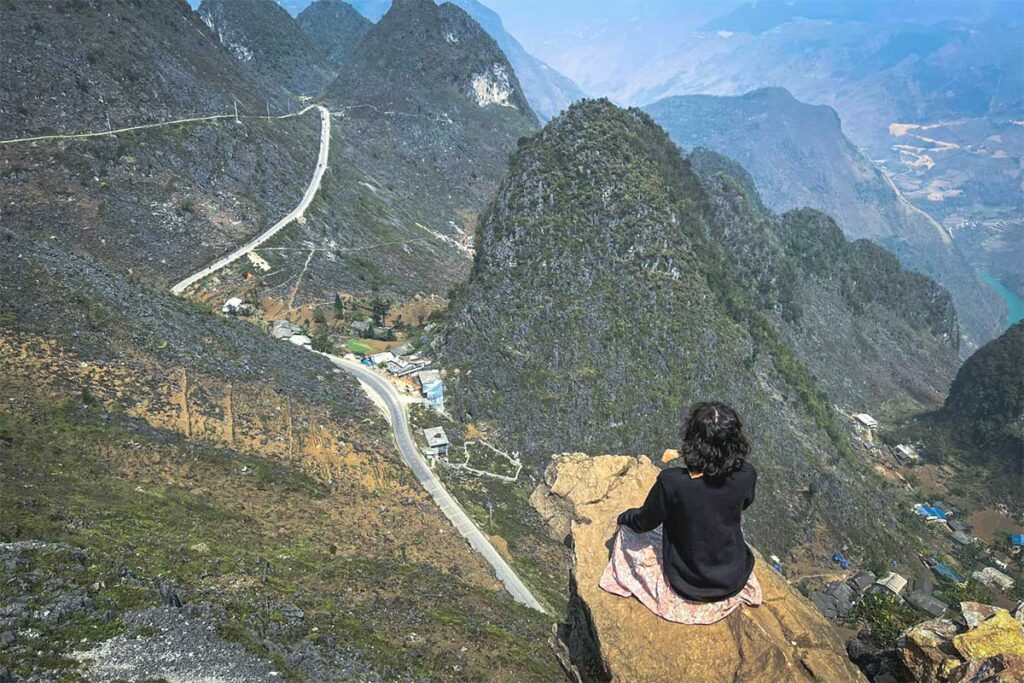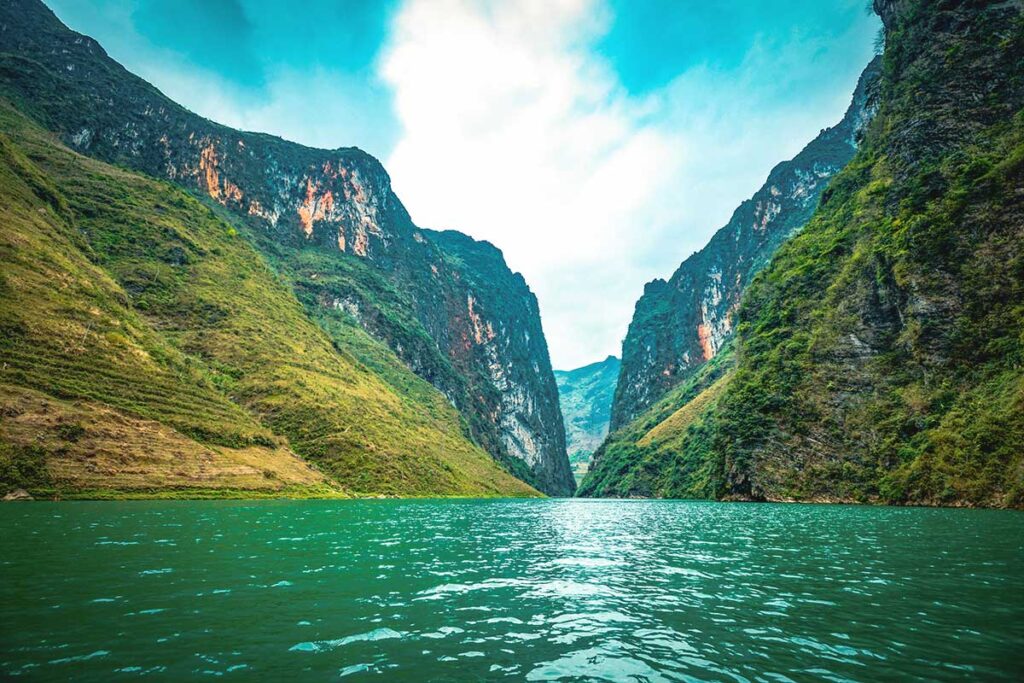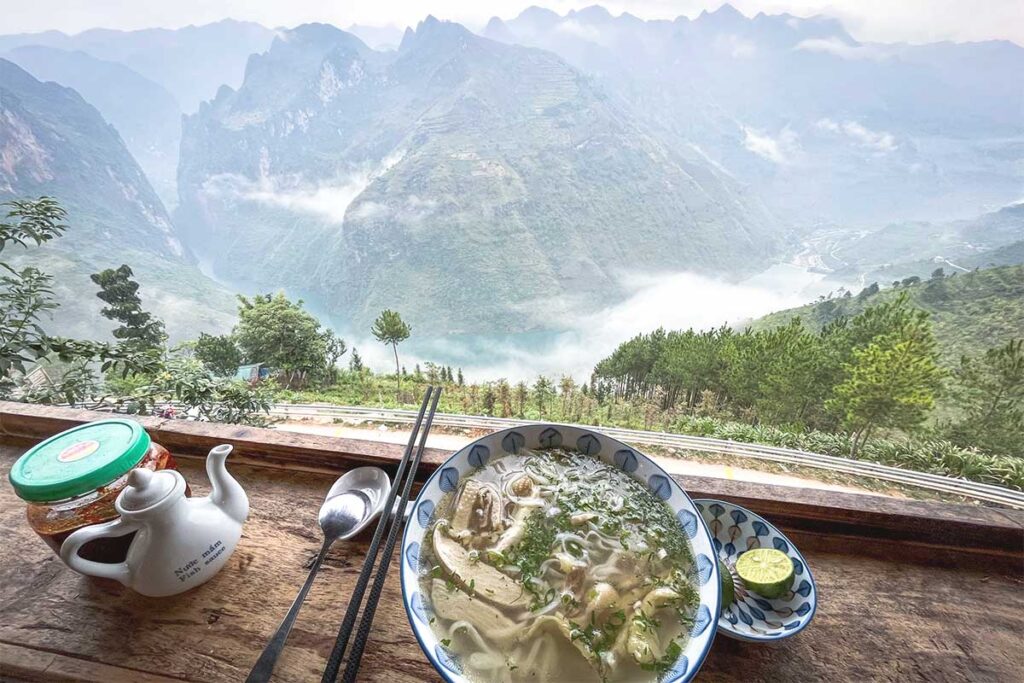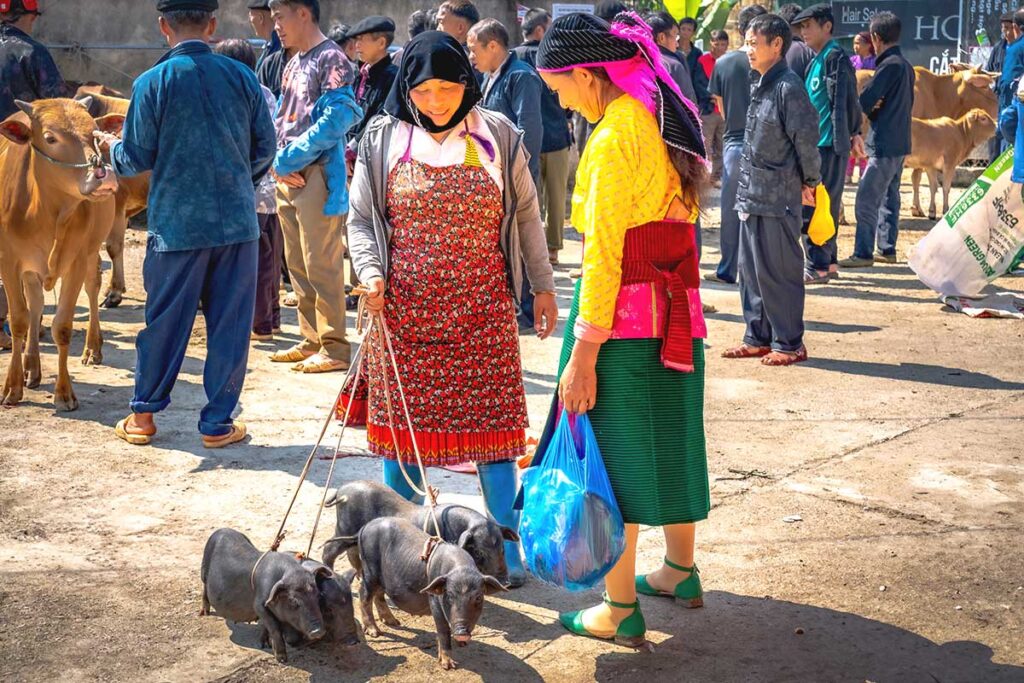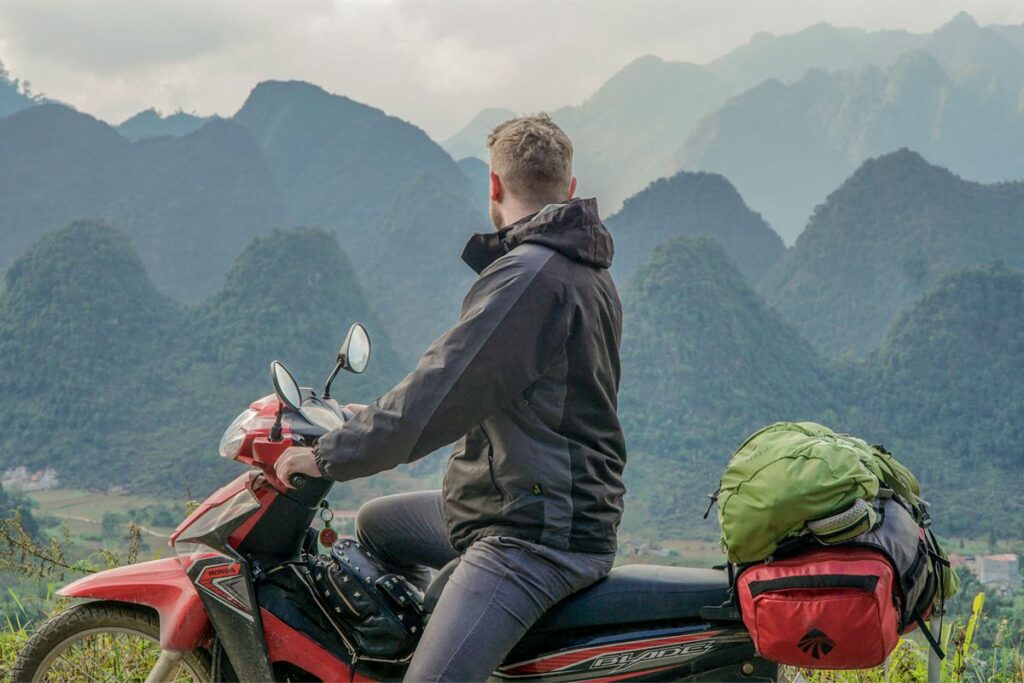About Ma Pi Leng Pass
Ma Pi Leng Pass is often referred to as the “King of Vietnamese mountain passes” for its jaw-dropping landscapes and dizzying cliffside roads. It sits at 1,500 meters above sea level and is part of National Road 4C, better known as “The Happiness Road.”
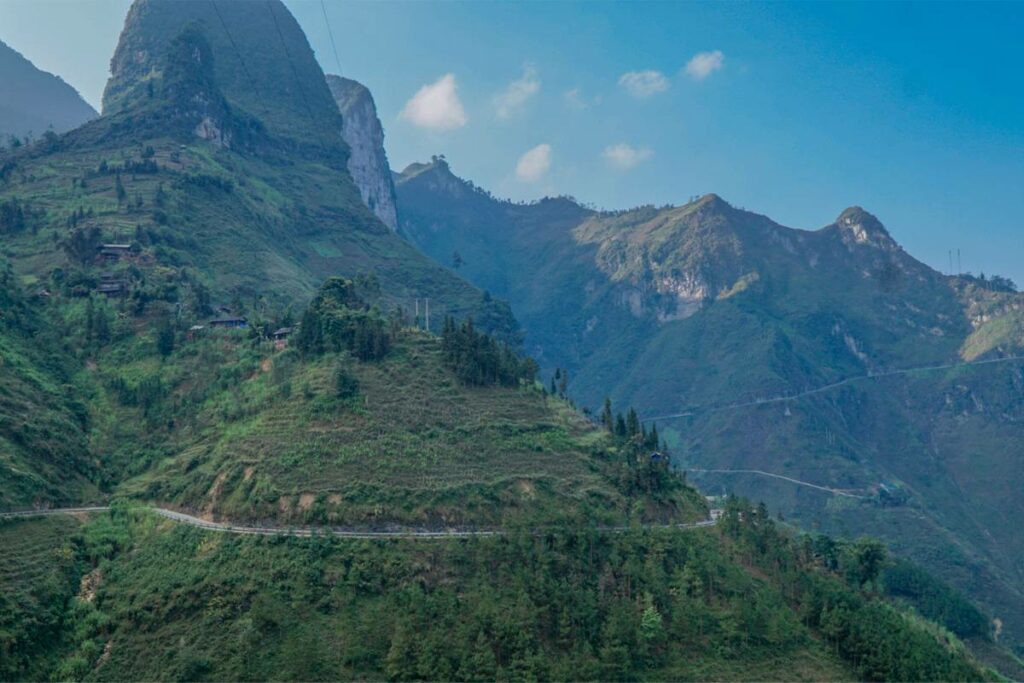
Where is Ma Pi Leng Pass?
The pass is located in Ha Giang Province, running between Dong Van and Meo Vac, two of the most remote towns in northern Vietnam, close to the Chinese border. It is a key part of the Ha Giang Loop, the famous motorbike route that showcases Vietnam’s most spectacular mountain scenery. (location on Google Maps)
History & importance
Ma Pi Leng Pass was built in the 1960s by thousands of workers, many of them ethnic minorities from the region. The construction of the road was incredibly difficult, as workers had to carve through the rugged limestone mountains using only hand tools and explosives. It took 11 years to complete, and today, it remains an essential connection for local communities and traders.
Why is Ma Pi Leng Pass Special?
- For Ethnic Communities: The pass provides a vital route for local ethnic minorities, such as the Hmong and Dao, to travel and trade between Dong Van and Meo Vac.
- For Travelers: It is considered one of the biggest highlights of Ha Giang, with endless viewpoints, sharp hairpin bends, and breathtaking views over the Nho Que River canyon.
- For Adventure Seekers: Driving Ma Pi Leng Pass is an unforgettable experience, with sheer drops, rugged cliffs, and some of the most epic motorbike routes in Vietnam.
Best things to do at the Ma Pi Leng Pass
The Ma Pi Leng Pass isn’t just about the drive—there are plenty of ways to experience its breathtaking scenery and surrounding cultural highlights. Whether you’re riding through the pass, walking along its highest ridges, or taking a boat trip below, here are the best things to do at Vietnam’s most spectacular mountain pass.
1. Drive the pass by motorbike or open-top jeep
The best way to experience Ma Pi Leng Pass is on two wheels or in an open-roof jeep. Riding a motorbike gives you complete freedom to stop anywhere along the road, while an open-top jeep tour provides the thrill of the wind in your face without the need to drive yourself. Cars are also a fine option, but the experience isn’t quite the same as feeling fully immersed in the landscape.
2. Stop for scenic views
This isn’t a road to rush through—take your time to soak in the incredible scenery. Along the pass, you’ll find various viewpoints, some with small coffee shops and parking areas, but many of the best views are simply along the roadside. You can stop at any safe spot, but be cautious when pulling over, especially on sharp curves.
3. Walk the Ma Pi Leng Skywalk
For those who want to experience the raw beauty of the pass on foot, the Ma Pi Leng Skywalk is an absolute must. This high-altitude trail follows the cliffs above the main road, offering even more dramatic views than from the pass itself. If you’re up for a short but unforgettable walk, this is one of the best ways to experience Ma Pi Leng’s grandeur.
4. Take a boat tour on the Nho Que River
Far below the towering cliffs of Ma Pi Leng, the emerald-green Nho Que River winds through the canyon. You can take a boat tour or even kayak through the Tu San Canyon, Vietnam’s deepest canyon. This is one of the most unique boat trips in Vietnam, where you’ll feel completely surrounded by dramatic limestone mountains.
5. Stay overnight on the Pass
If you can’t get enough of the stunning views, you can spend the night on the Ma Pi Leng Pass. While not necessary for most travelers, staying overnight offers a rare chance to watch the sunrise or sunset over the mountains. There are only a few accommodations in this remote area, so it’s best to book in advance if you plan to stay.
6. Explore more than just the pass
The Ma Pi Leng Pass is just one piece of Ha Giang’s incredible landscape and culture. The ethnic villages of the Hmong, Tay, and Dao people are just as fascinating as the mountain scenery. Both Meo Vac and Dong Van host vibrant Sunday markets, where locals gather in colorful traditional dress to trade goods, livestock, and stories. If you have time, explore the roads leading to Lung Cu (Vietnam’s northernmost point) or Meo Vac to Mau Due, which rival Ma Pi Leng in beauty.
How to get to Ma Pi Leng Pass
While Ma Pi Leng Pass is one of Vietnam’s most spectacular drives, it is not a standalone destination. Travelers don’t journey for hours just to see the pass—it is part of a larger adventure through Ha Giang’s incredible landscapes. Over time, this has created a famous route known as the Ha Giang Loop, a multi-day journey that showcases the best of the province. The loop typically takes 3 to 5 days (or longer for those wanting a slower pace) and starts and ends in Ha Giang City.
Tip: Cross Ma Pi Leng Pass on a Ha Giang Loop tour
Ma Pi Leng Pass is one of the most scenic roads in Vietnam and a highlight of our Ha Giang Loop tours. All tours include transport, local guides, and stops at key viewpoints. Explore the full list of tour options that include the pass here.
Getting to Ha Giang City from Hanoi
The first step to experiencing Ma Pi Leng Pass is reaching Ha Giang City, the gateway to the Ha Giang Loop. There is no airport or train station in Ha Giang, so the only way to get there is by road:
- Sleeper Bus (Best for Budget Travelers) – Comfortable overnight buses depart Hanoi in the evening and arrive in Ha Giang early morning (6–7 hours).
- Limousine Van (Best for Comfort) – Daytime limousine vans offer a more comfortable ride but take longer (7–8 hours).
- Private Car (Best for Convenience) – The most expensive option but the most flexible, with direct hotel pick-up and drop-off.
Options for driving the Ma Pi Leng Pass
Once in Ha Giang City, you will embark on the Ha Giang Loop, which includes driving over the Ma Pi Leng Pass. There are three main ways to experience this epic mountain road:
Driving a motorbike (Best for adventure seekers)
- The most popular option, offering complete freedom to stop wherever you like.
- Requires prior motorbike experience, as the roads are steep and winding.
- Motorbike rentals are widely available in Ha Giang City.
- Important: A motorbike license is required for legal riding.
Easy rider tour – On the back of a motorbike (Best for safety & comfort)
- A great option if you want the thrill of riding but don’t feel confident driving yourself.
- An experienced local guide will handle the motorbike, allowing you to relax and enjoy the views.
- Easier to navigate the challenging roads, with added cultural insights from your guide.
Car or jeep tour (Best for comfort & group travel)
- The most comfortable option, especially in cold or rainy weather.
- Jeep tours offer open-roof vehicles, giving an immersive experience of the mountain scenery.
- More expensive than motorbike options but great for families or groups.
The drive over the Ma Pi Leng Pass
Starting from Dong Van, the road gradually ascends, winding through dramatic limestone peaks and deep valleys. Along the way, you’ll pass through small ethnic villages, home to Hmong, Tay, and Dao communities. These villagers live much as they have for generations, farming on steep slopes and wearing colorful traditional clothing. You’ll see women tending rice fields, children herding buffalo, and men leading cattle along the roadside.
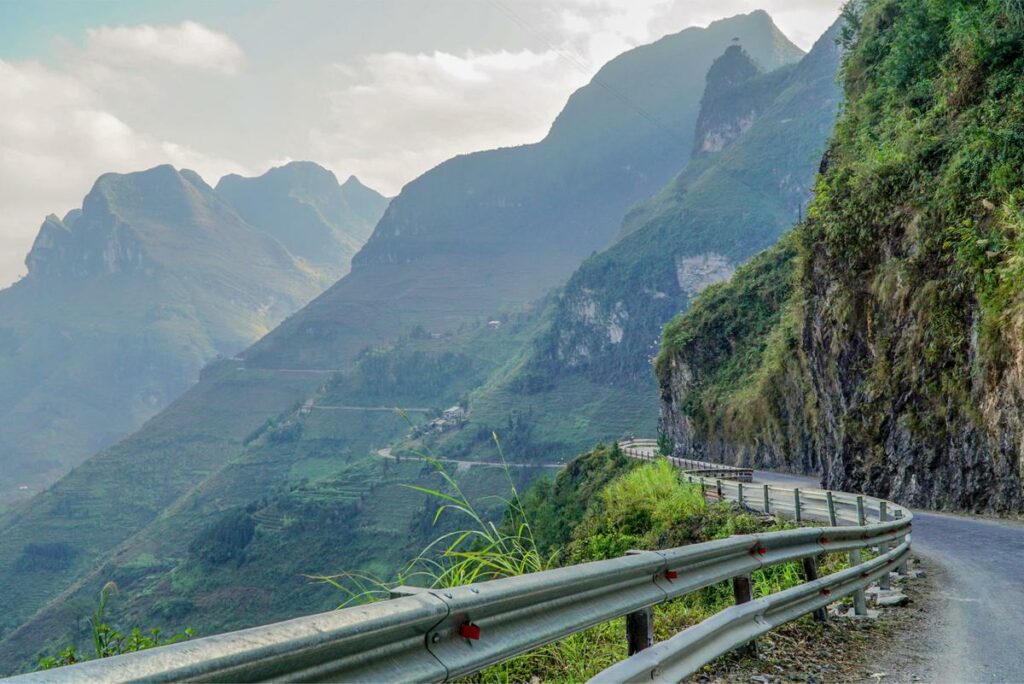
As the road climbs higher, the landscape becomes increasingly rugged. Soon, you’ll reach the most breathtaking section of Ma Pi Leng Pass, where sheer cliffs drop hundreds of meters down to the emerald waters of the Nho Que River. This is one of the most dramatic canyon views in all of Vietnam.
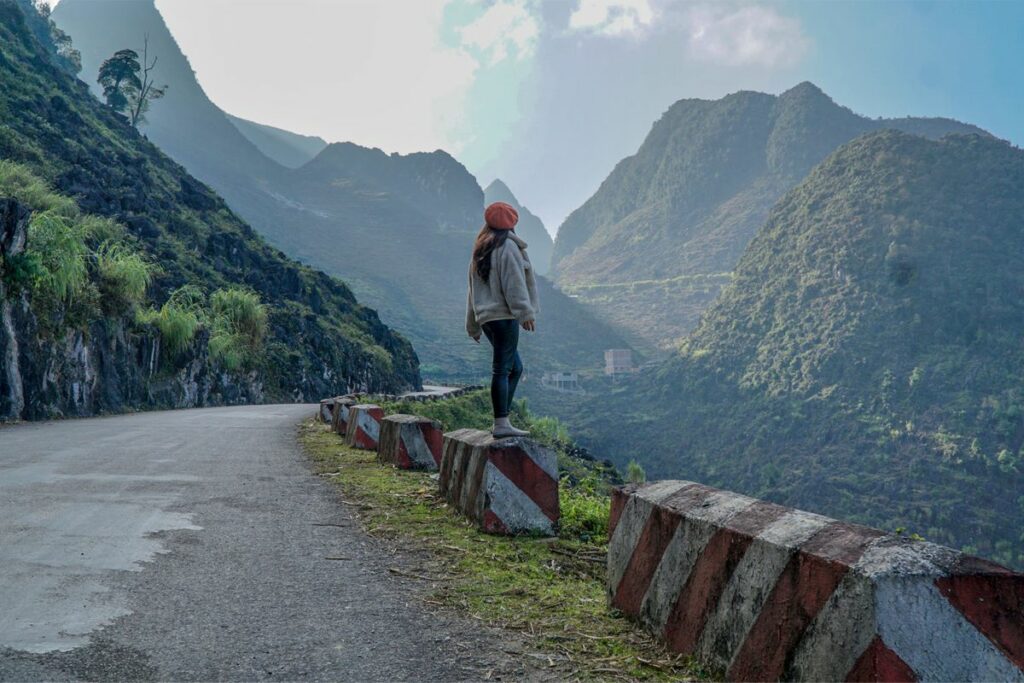
There are several viewpoints along the pass where you can stop to soak in the scenery and take photos. Some are official parking areas, while others are just roadside pull-offs. Be cautious when stopping on the road, as Ma Pi Leng Pass is also an important transportation route between Dong Van and Meo Vac.
Happiness road museum
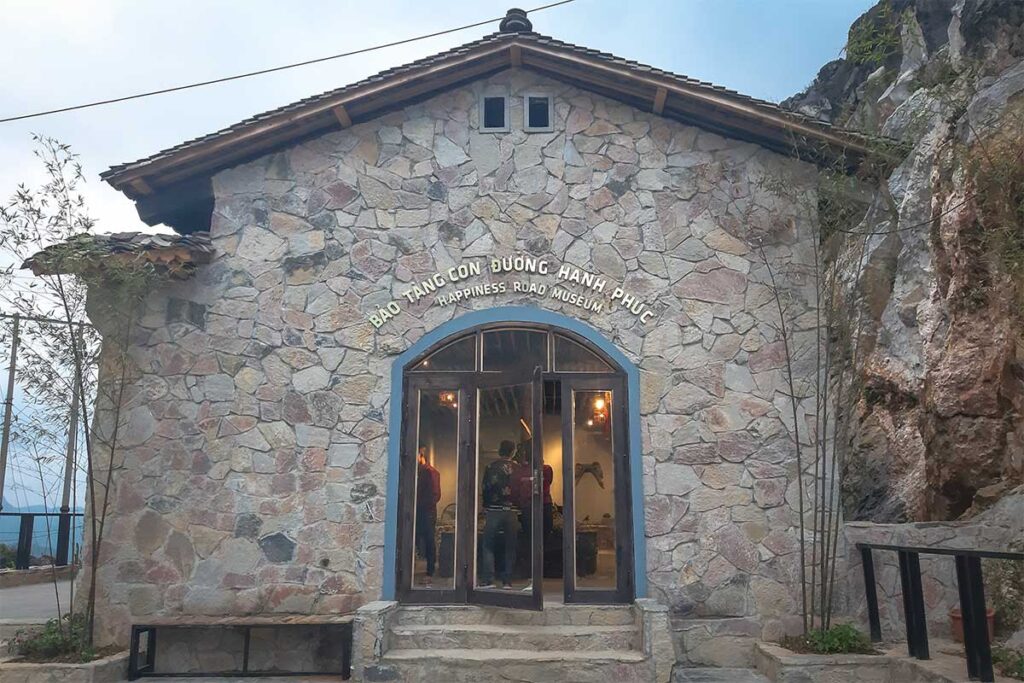
About halfway along the pass, you’ll find the Happiness Road Museum, a small but interesting stop that tells the story of the construction of Ma Pi Leng Pass. This is also the starting point of the Ma Pi Leng Skywalk, a stunning hike along the ridgeline that offers even more dramatic views of the canyon below.
After the museum, the road begins its descent into Meo Vac, offering a different perspective of the landscape as you leave the high cliffs behind. The drive from Dong Van to Meo Vac takes about 45 minutes to an hour, but with stops, expect to spend much longer enjoying the scenery.
Ma Pi Leng Skywalk
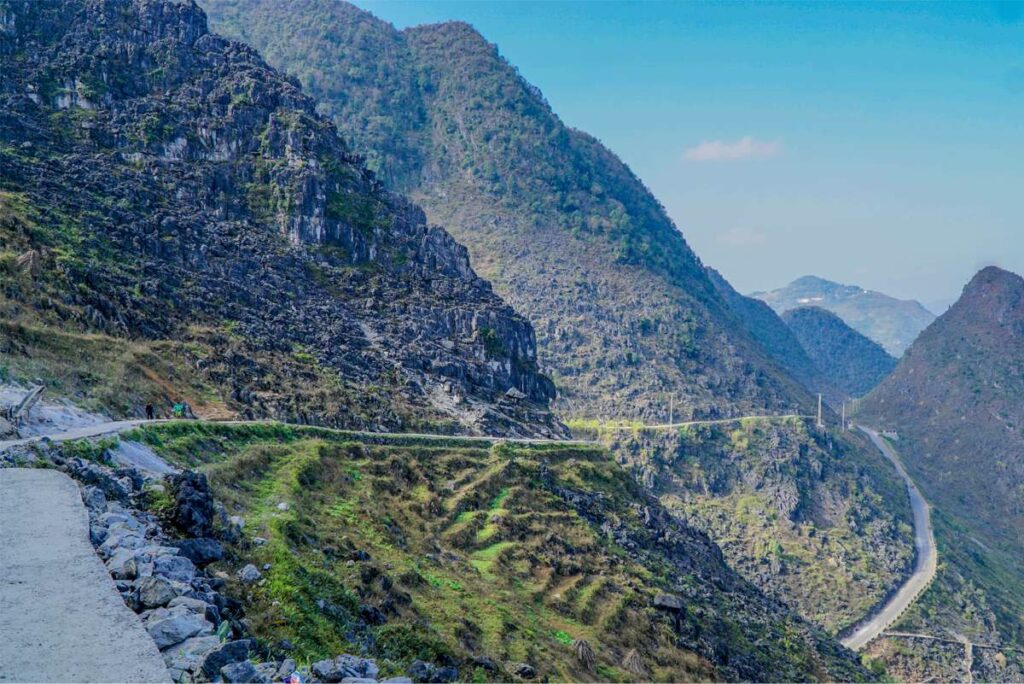
The Ma Pi Leng Skywalk is a thrilling pathway running higher up on the Ma Pi Leng Pass, offering some of the most spectacular panoramic views of the surrounding mountains, valleys, and the winding Nho Que River below. Previously accessible by motorbike, the Skywalk is now strictly for pedestrians, allowing visitors to fully take in the breathtaking scenery without the risk of navigating a vehicle along the steep cliffs.
Starting point & route
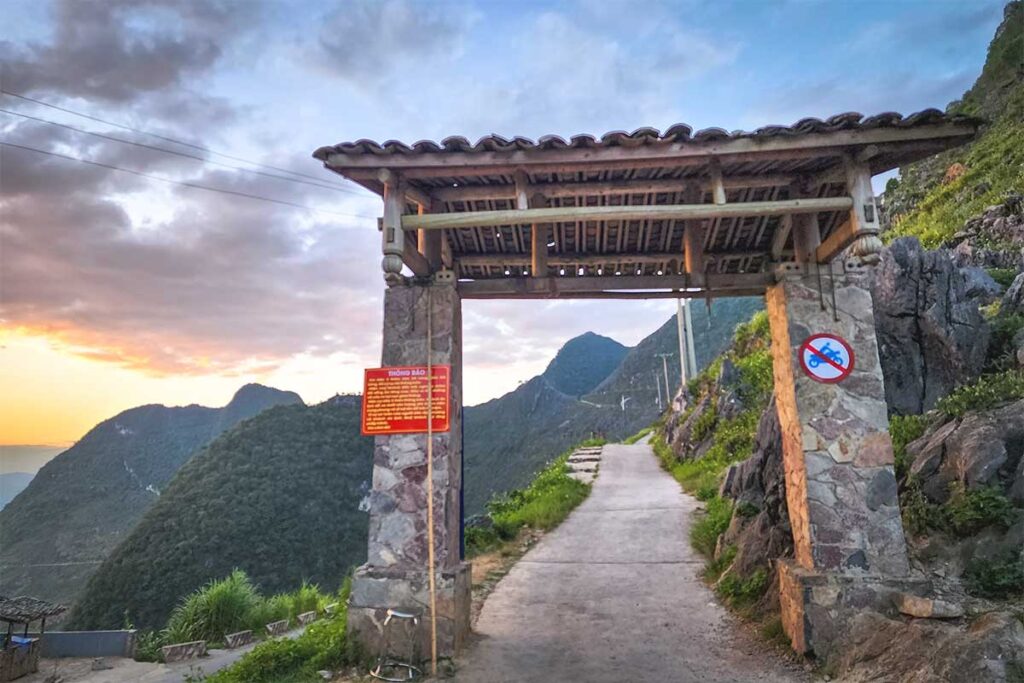
The Skywalk begins at the Happiness Road Museum, where you can park your motorbike or car before setting off on foot. The path is concrete and well-maintained, though it remains narrow, with dramatic drops in certain areas. In 2020, the walkway was widened, making it safer and more accessible, but the sense of adventure remains.
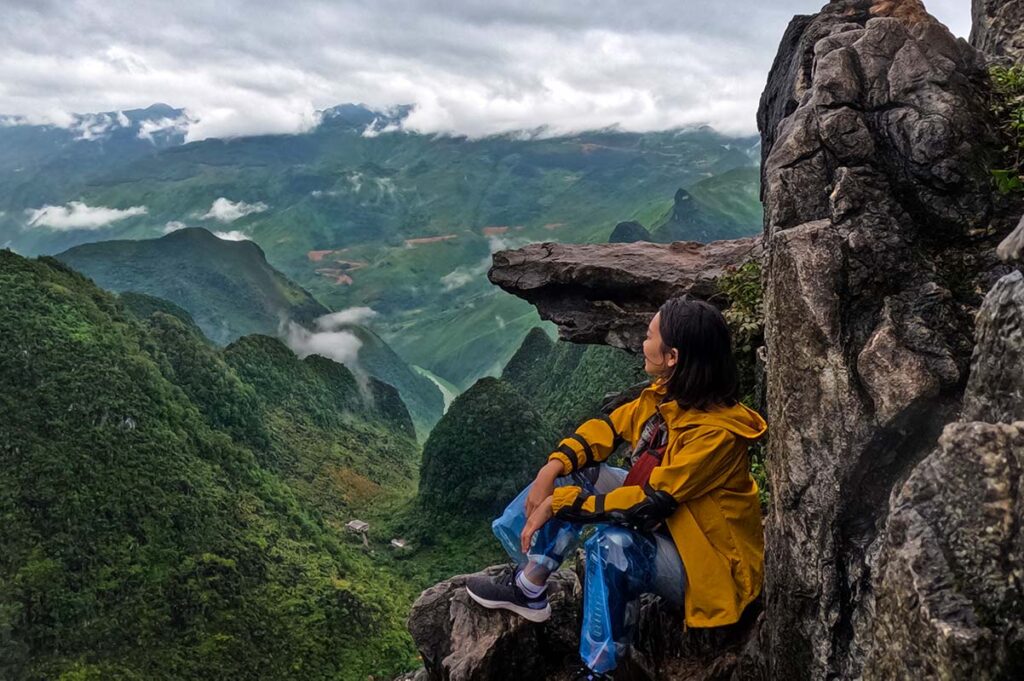
As you walk along the ridge, you’ll be able to see the main Ma Pi Leng Pass road far below, snaking through the mountains. Along the route, there are stunning rock formations that provide excellent photo opportunities, including a large rock overhang where it appears as though you’re standing on the edge of the world.
The Eye of Ma Pi Leng
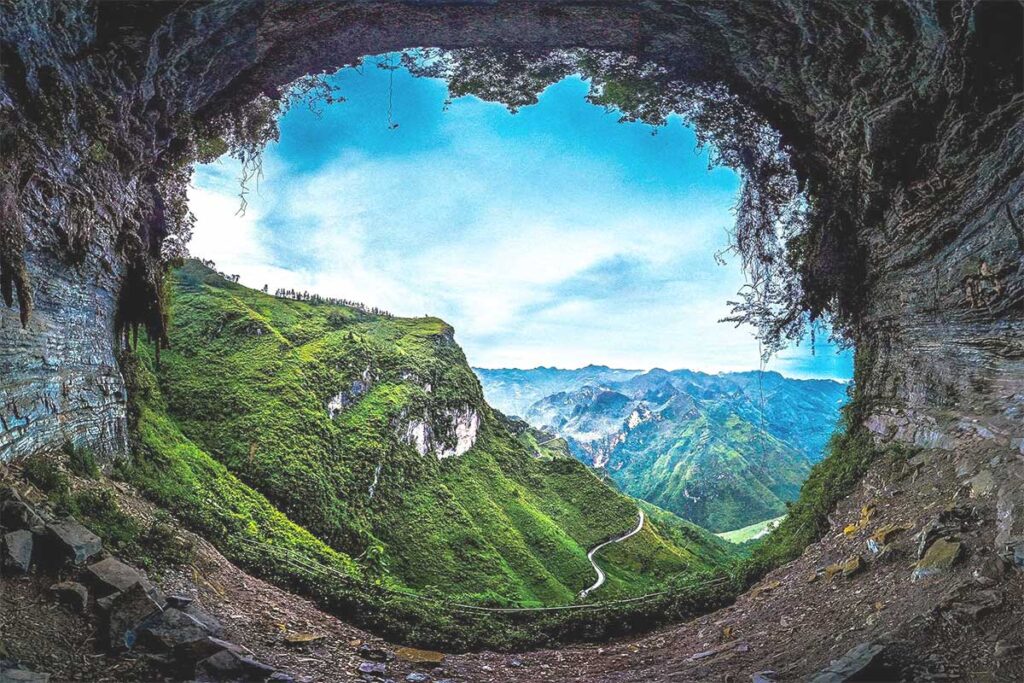
About 700 meters beyond the main viewpoint, you’ll come across a natural cave passage in the mountainside, known as “The Eye of Ma Pi Leng.” This unique formation—a hole within the rock face at an elevation of 1,300 meters—creates an incredible window-like view of the surrounding peaks and valleys. It’s one of the most iconic photography spots along the Skywalk and a must-visit for those seeking a truly unique perspective of the landscape.
Things to keep in mind
- Footwear: The path is relatively easy to walk, but proper walking shoes are recommended for stability.
- Safety: While the path is in good condition, there are no guardrails in some sections, so be cautious, especially on windy days.
- Time Needed: Expect the walk to take 30 minutes to 1 hour, depending on how often you stop for photos.
The Ma Pi Leng Skywalk offers an unparalleled experience of Ha Giang’s rugged beauty, making it one of the most scenic short hikes in Vietnam.
Boat trip on the Nho Que river
What many travelers don’t realize is that you can actually descend from the Ma Pi Leng Pass down to the Nho Que River and explore it from the water. The journey down is an adventure in itself—several winding roads lead to the river, but be aware that they are extremely steep and narrow with sharp hairpin bends. If you’re not confident riding a motorbike on such roads, there is a motorbike taxi service operated by locals, which is a safer and more convenient option.
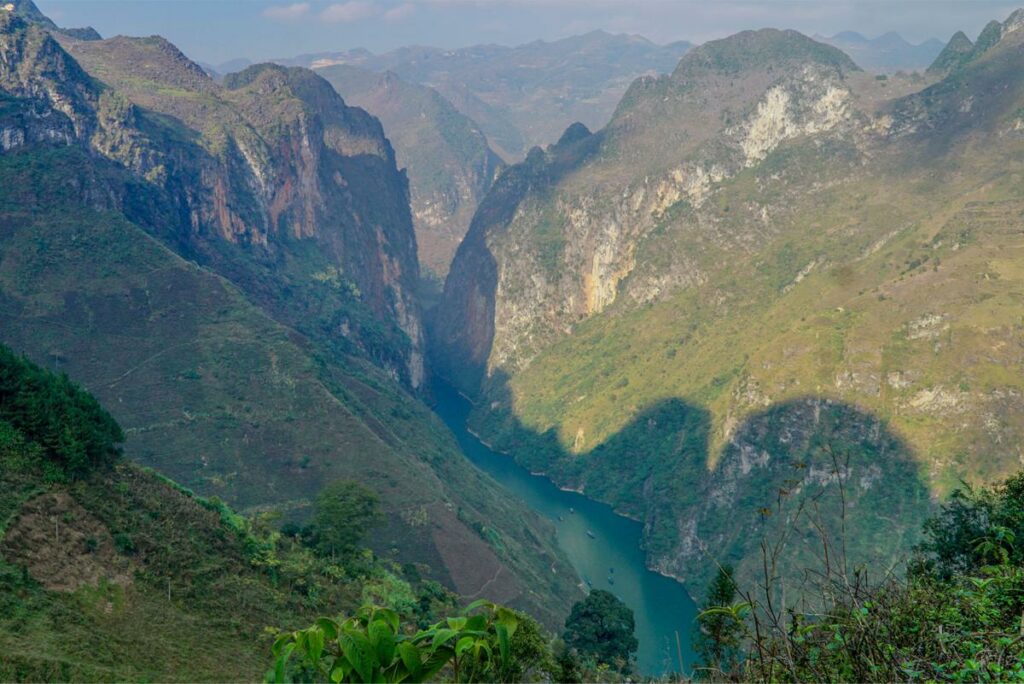
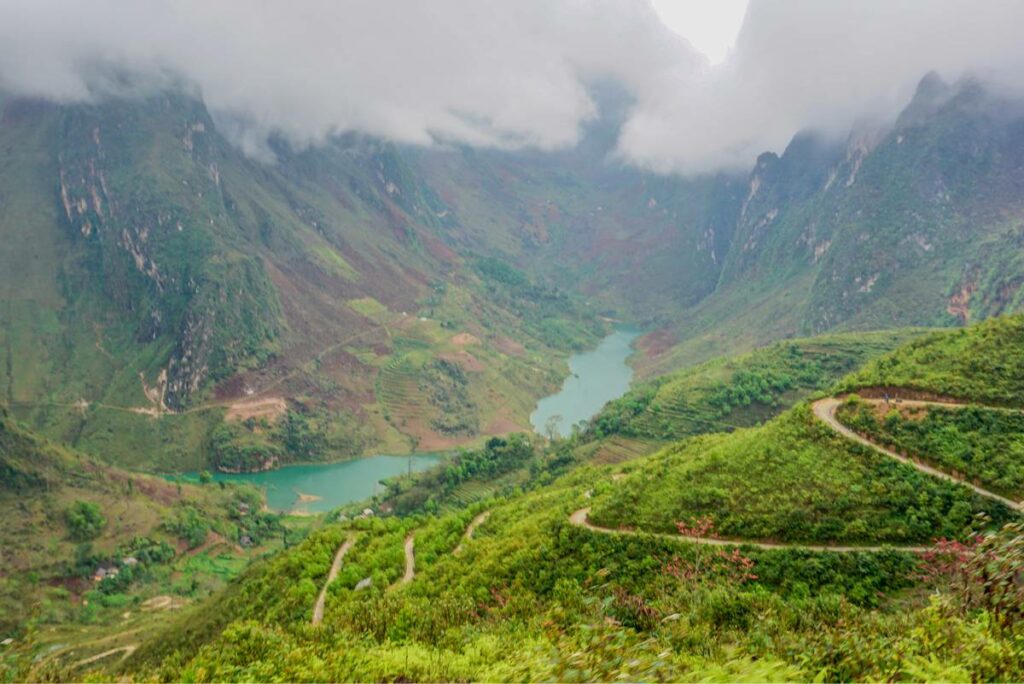
Once you reach the river, you can take a 1-hour boat tour through the stunning Tu San Canyon, the deepest canyon in Vietnam, for 300,000 VND per boat (approximately 12 USD). As you cruise through the emerald-green waters, you’ll be surrounded by steep cliffs and towering limestone formations, offering a completely different perspective of the Ma Pi Leng landscape. Unlike the high-altitude views from the pass, the canyon is often clear of clouds, providing stunning visibility of the dramatic rock walls above.
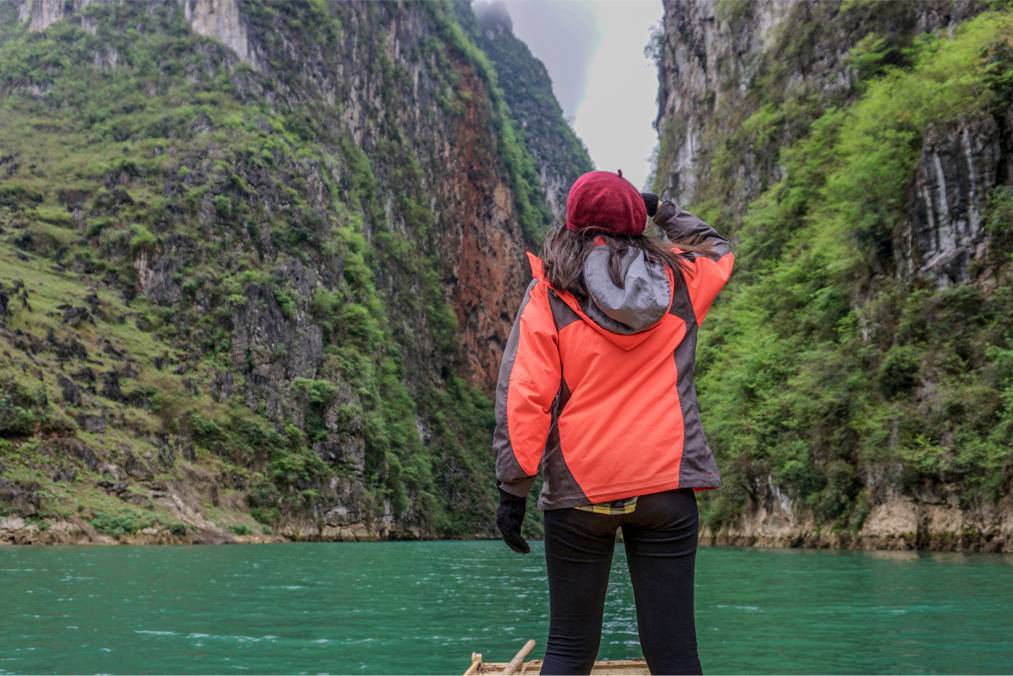
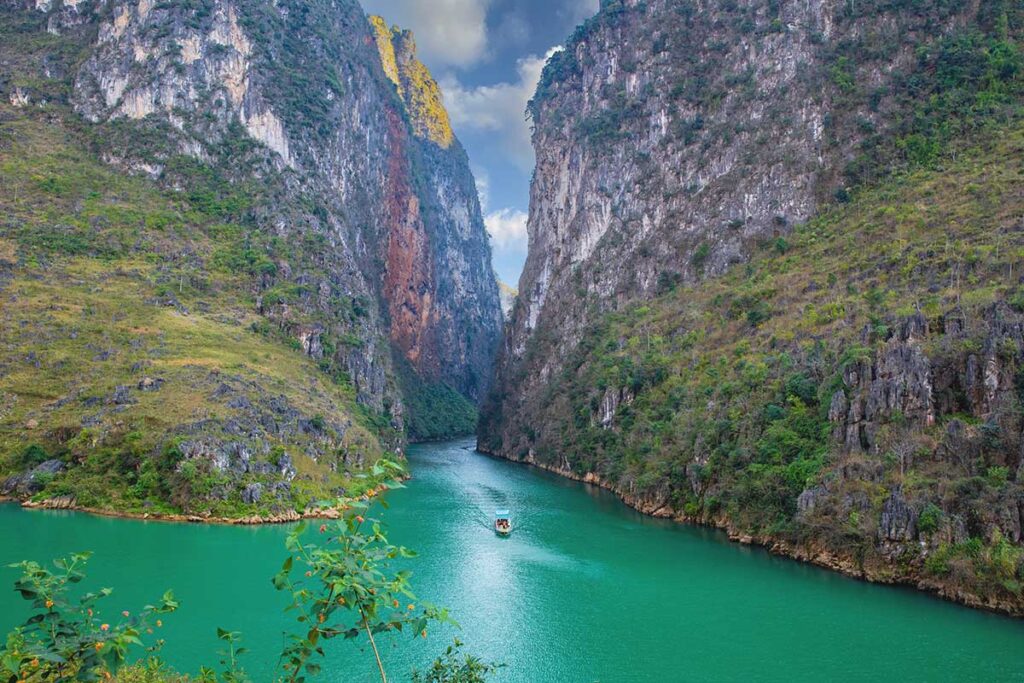
For those seeking a more adventurous experience, kayaking on the Nho Que River is also an option. However, kayak rentals are not as widely available and are best arranged in advance through a local homestay or tour operator. Whether by boat or kayak, this trip is an absolute must-do for anyone visiting Ma Pi Leng Pass, offering a unique way to experience the landscape from below rather than above.
Accommodation at the Ma Pi Leng Pass
Is it worth staying on the Ma Pi Leng Pass?
Staying overnight on the Ma Pi Leng Pass is not necessary, but it can be a unique experience for those wanting to wake up surrounded by breathtaking mountain scenery. Since the pass is remote with limited accommodation options, most travelers opt to stay in Dong Van or Meo Vac, which both offer a wider range of homestays and small hotels. These towns also have more dining options, making them a more practical choice.
That said, if you truly want to immerse yourself in the dramatic landscapes of the pass, there are a few homestays available directly on Ma Pi Leng. Keep in mind that while the views are spectacular, these accommodations come with some trade-offs—limited facilities, potential noise from the road, and fewer food options.
Recommended accommodation on the Ma Pi Leng Pass
Ma Pi Leng EcoLodge
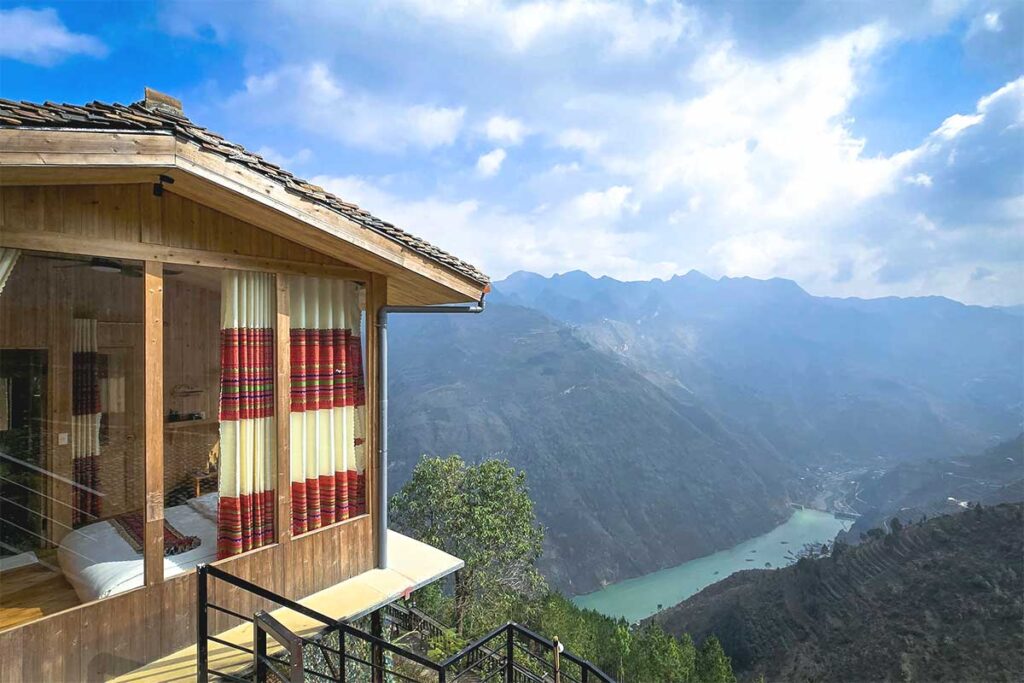
Offers incredible views over the Nho Que River, but sits directly above the main road, so traffic noise is common. Rooms are comfortable, but thin walls and bright outside lighting can disturb sleep. The on-site restaurant is the only food option nearby, with limited menu choices and higher prices than in town.
Ma Pi Leng Homestay & Restaurant
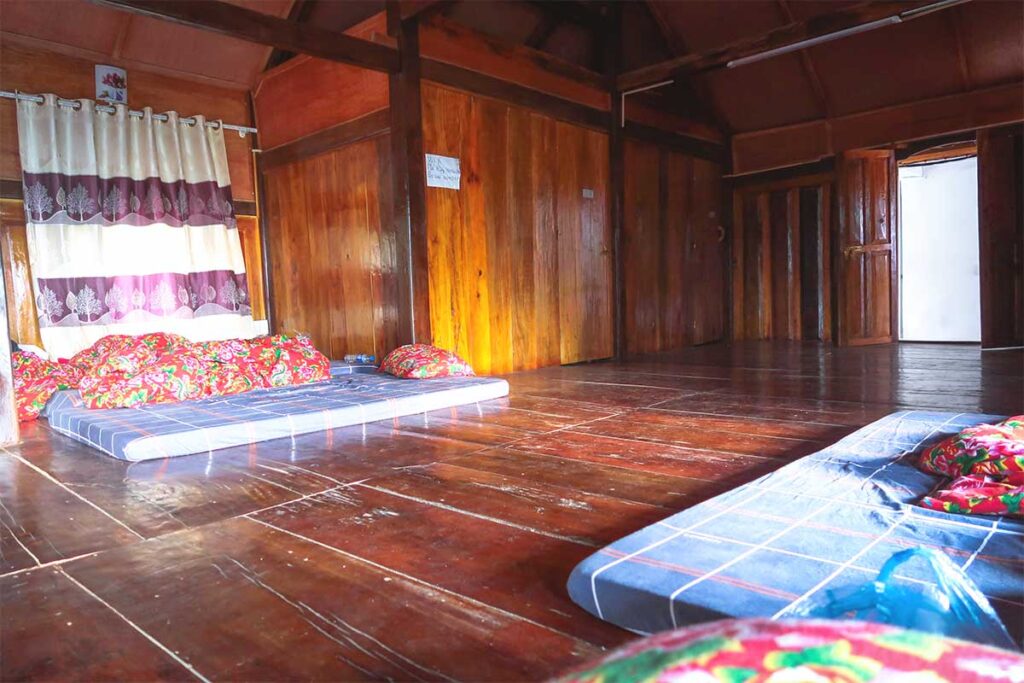
A local, family-run homestay with cozy traditional rooms. Great home-cooked meals, and the host, Mr. Khanh, is known for his warm hospitality. Can get very cold in winter, so bring warm clothes.
Ma Pi Leng Heritage
A simple homestay right next to the Ma Pi Leng Skywalk, perfect for early morning hikes. The family dinners and social atmosphere are a highlight, but music and late-night drinking can make it noisy.
Travel tips for Ma Pi Leng Pass
Is Ma Pi Leng Pass Dangerous?
While Ma Pi Leng Pass is one of Vietnam’s most dramatic roads, it is not inherently dangerous as long as you drive carefully. The road is paved and well-maintained, but some sections lack guardrails and have steep drop-offs. In rainy or foggy weather, visibility can be low, so drive cautiously, especially on the sharp turns.
Best time to visit & weather
The best time to visit Ma Pi Leng Pass is October to February, when the weather is dry and the skies are clearer, but temperatures can be cold, especially at night. Spring (March – May) and autumn (September – November) generally offer comfortable temperatures and less chance of fog. Summer (June – August) brings warmer weather but also more rain, which can make the road slippery. If possible, avoid foggy days, as they reduce visibility and impact the views.
What to Bring
- Warm layers – It can get cold and windy, especially in the morning and evening.
- Rain jacket – The weather is unpredictable, and a sudden rain shower can happen.
- Water & snacks – There are few food stalls along the pass, so bring enough for the journey.
- Cash – Some coffee shops and homestays only accept cash, and ATMs are scarce in the area.
- Offline maps – Mobile signal can be unreliable, so download maps in advance.
Example itinerary for Ma Pi Leng Pass & Ha Giang Loop
Most travelers combine Ma Pi Leng Pass with the Ha Giang Loop, as the pass is a highlight of the route. Here are some sample itineraries:
3 Days
- Day 1: Ha Giang → Dong Van
- Day 2: Dong Van → Ma Pi Leng Pass → Meo Vac
- Day 3: Meo Vac → Ha Giang
4 Days
- Day 1: Ha Giang → Yen Minh
- Day 2: Yen Minh → Dong Van
- Day 3: Dong Van → Ma Pi Leng Pass → Meo Vac
- Day 4: Meo Vac → Ha Giang
5 Days
- Day 1: Ha Giang → Yen Minh
- Day 2: Yen Minh → Dong Van
- Day 3: Dong Van → Ma Pi Leng Pass → Meo Vac
- Day 4: Meo Vac → Du Gia
- Day 5: Du Gia → Ha Giang
Other things to see around Ma Pi Leng Pass
Since Ma Pi Leng Pass is part of the Ha Giang Loop, it’s best to combine it with other attractions in the region:
- Tham Ma Pass – Another scenic mountain pass located on the route from Ha Giang City to Dong Van.
- Hmong King Palace – A historical residence of Hmong royalty, showcasing traditional architecture and history.
- Sung La Valley – Known for its flower fields and the traditional House of Pao, featured in a famous Vietnamese movie.
- Lung Cu Flag Tower – The northernmost point of Vietnam, offering panoramic views and a deep cultural significance.
If you have extra time, consider spending an additional night in Meo Vac or Dong Van to explore more of the local villages and markets.
